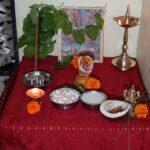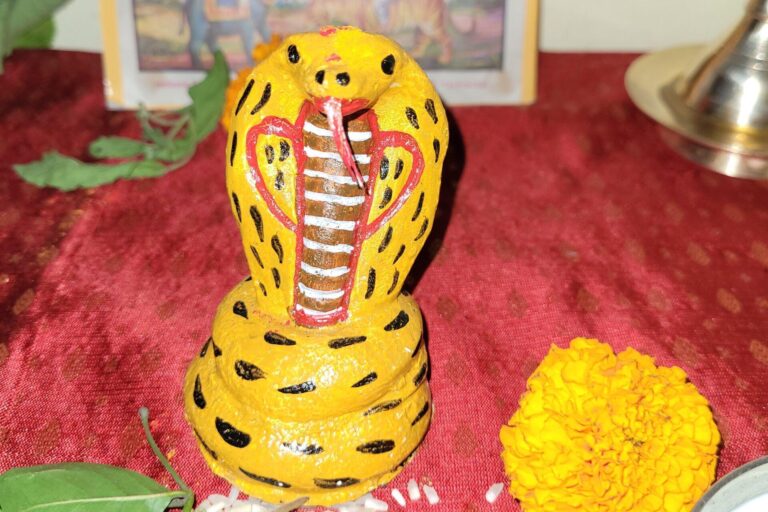Hello and welcome to MaharashtraDiscovery.com! Today, we’re going on a journey to learn about Nag Panchami, a special festival in Maharashtra. This celebration means a lot to me personally because I truly enjoy it. I love wearing our traditional attire, like the elegant saree, and performing the pooja just as our ancestors did. Nag Panchami holds a special place in my heart. The excitement, the gatherings of family and friends, and the meaningful rituals create memories that last a lifetime.
In different parts of Maharashtra, Nag Panchami is celebrated with great devotion, and each region adds its own special touch with unique rituals. This festival brings people together, showcasing the diversity of our state’s culture. But there’s one thing that remains the same throughout: the love and respect we have for snakes. The bond between us and these sacred creatures is truly remarkable and it’s a tradition that has been passed down through generations.
So, let’s dive into the cultural significance, the various ways it’s celebrated in different parts of Maharashtra, and let’s celebrate the special bond with snakes during Nag Panchami. Together, we’ll cherish the joy and embrace the richness of our heritage.
Significance of Nag Panchami
The first festival in Shravan is known as Nag Panchami. On the fifth day of Shravan’s bright half, which is known as Panchami, the defeat of the serpent Kaliya by Lord Krishna is celebrated. He emerged safely from the Yamuna river after subduing Kaliya. That day is celebrated as Nag Panchami. On this day, the puja of eight serpents is performed: Ananta (Shesha), Vasuki, Padmanabha, Kambala, Shankhapala, Dhritarashtra, Takshaka, and Kaliya. Among the symbols of Lord Shiva, the serpent holds importance. Similarly, the serpent is also considered a symbol of Lord Vishnu. Because the month of Shravan is highly revered for the worship of Lord Shiva,
Preparations for Nag Panchami: The Excitement Builds
The anticipation of Nagapanchami fills the air as families and communities come together to prepare for the festivities. Homes are cleaned and decorated with beautiful rangolis to welcome prosperity. Devotees gather pooja materials, crafting snake idols and selecting radiant flowers for the sacred rituals.
On this day, either draw a picture of a snake on a wooden board or on wall, or make a clay snake, and worship them. Offer milk to the snake Idol. Offer Haldi, Kumkum, Durva grass, sandalwood paste, akshata (rice grains), and flowers during the puja. At the time of worship, recite the mantra “नमोsस्तु सर्पेभ्यो ये के च पृथ्वी मनु!’ ये अंतरिक्षे ये दिवि तेभ्य: सर्पेभ्यो नम:!”. When you worship the snake deity on Nag Panchami, the effects of Kaal Sarp Dosha and Sarpa Dosha are eliminated.
According to ancient scriptures, performing puja to the snake deity on Nag Panchami keeps away the fear of snakes from the family. On this day, a clay snake idol is prepared and placed on the main entrance of the house, adorned with Durva and Sindoor. On Nag Panchami, there should be no ploughing, tilling, or grinding, and no cooking on a tawa (Indian frying pan or griddle used for cooking chapattis). Harming anyone or digging the ground should be avoided. We eat only boiled food. Offerings like dind (a type of food), patolya (a sweet dish), Kanule, modak (a sweet dumpling) are prepared, hinting at various connections and stories related to this day.
Please find traditional Kanule recipe on this link https://youtu.be/zl4mAw87_Ic
Modak Reciep – https://maharashtradiscovery.com/modak-recipe/
Explore the Pooja Vidhi on our YouTube Channel @Maharashtra_Discovery!”

Discover everything you need to know about the unique traditions of Nag Panchami by watching our detailed Pooja Vidhi tutorial on YouTube. Simply click on this link: https://www.youtube.com/@Maharashtra_Discovery. Prepare to enter the realm of sacred rituals and truly grasp the significance of this extraordinary festival. The video will guide you through the steps of the rituals, bringing you closer to the celebration and the distinct energy associated with serpents.
Farmers and Snakes: A Special Bond Celebrated in Nagpanchami
In rural Maharashtra, during the special Nagpanchami festival, farmers and snakes share a special connection. When the month of Sravan arrives, farmers gather to celebrate this old tradition. Farmers respect snakes because they help keep the fields balanced. Snakes are like protectors, making sure there aren’t too many rodents that could harm the crops.
During Nagpanchami, farmers pray to Nagdevata (snake deity) seeking protection against snake bites while they work in the fields.. They also say sorry if they ever did something to hurt snakes. This tradition is a way of saying thanks to these helpful snake friends. It’s not just a regular practice; it’s a way to show how much they appreciate nature’s balance. This friendly link between people, nature, and snakes shows the smart teachings in country traditions.
Nag Panchami Tale: A Lesson in Kindness and Gratitude
Once, there lived a farmer who was working in his field. By accident, he disturbed a snake’s home in the ground. This made the baby snakes inside very unhappy, and they started making angry sounds by hissing. The snake that lived outside saw this and got angry too. It ended up biting the farmer’s wife and children.
Now, the farmer had a daughter who was already married. This daughter wanted to make things better. She decided to do something special. She prayed for the snake by offering milk and flowers in front of a picture of it. She wanted to make peace and ask for forgiveness. When she poured the milk, she saw that the snake in the picture seemed to become calmer. She even drank some of the milk herself to show she didn’t want to hurt anyone. Because she did this kind thing, the snake’s anger went away. It didn’t harm her family anymore.
The purpose behind the ritual of Naga Pooja is to express gratitude to the snakes and to make the society aware of the importance of snakes. This special ceremony is a way to show respect to these creatures and to remind us that they play a significant role in our environment.
Aghada Leaves and Jowar Puffs
During Nagapanchami, Aghada leaves and Jowar puffs hold special meanings due to their cultural and symbolic significance. Aghada leaves carry a deep importance in Hindu customs, including Nagapanchami. These leaves are regarded as sacred to snakes, embodying a connection to these creatures. Additionally, Aghada leaves find purpose in various other festivals as well.
Conversely, Jowar puffs hold a different significance. They symbolize offerings and sustenance. These puffs often play a role in the rituals by serving as symbolic food for snakes. Offering Jowar puffs reflects the respect and honor people hold for snakes, highlighting their role in preserving nature’s equilibrium. It’s a gesture of thankfulness towards these creatures and an acknowledgment of their significance in maintaining the ecological balance.
Cultural Significance
Nag Panchami is deeply connected to agriculture, symbolizing renewal and fertility. Farmers pray for abundant rainfall and a bountiful harvest.
Beyond its religious importance, Nag Panchami fosters social harmony and unity among different communities in Maharashtra.
Preserving the heritage of Nag Panchami is a sacred responsibility. It connects us to our roots and instills values like compassion and respect for all living beings.
We must pass down this legacy to the younger generation through storytelling and active participation to keep our cultural flame alive.
In conclusion, Nag Panchami is a timeless celebration that weaves together spirituality, tradition, and culture in Maharashtra. This festival teaches us the deep connection between humans and the natural world, symbolized by our reverence for snakes.
Let’s embrace Nag Panchami with open hearts and learn from the legends of Lord Krishna and Kaliya. As we celebrate this beautiful festival, may we spread love and harmony, cherishing the joy it brings.
https://maharashtradiscovery.com/maharashtra-festivals-rich-tradition/
